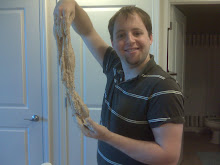Cooking only really requires a few basic techniques. One of the easiest, most prominent and all-around tastiest is the basic roasting of meat. Do it correctly and your meat will have an inviting crust on the outside, locking in juices and flavors galore on the inside. If you just stick it in the oven, the color, outer crust, inner moisture and overall flavor will be diminished. That's why it's all about the sear.
I employed this cooking method last week for basic roasted pork tenderloin. I did not marinate it, but I could have. And I could have done this with a variety of cuts of meat. I happened to have a pork tenderloin that I had bought on sale and wanted to make a quick dinner out of it, and then use the leftovers for a few more meals later in the week.
The two things I did first were to preheat the oven to 375 and to put a large pan dry over high heat. I wanted a scalding, “open the windows, open the doors” kind of hot for my sear. Make it quick and pain free.
I placed my pork in a prep bowl and then drizzled a couple teaspoons of olive oil over it, a pinch of kosher salt, some cracked pepper, a couple splashes of red wine vinegar and a large pinch of dried rosemary. With my two clean hands, I rubbed the dressing all over the tenderloin, making sure it got on and in every surface and crevice.
When the pan was hot, I placed my tenderloin in the pan, taking care to stretch it out full and not move it around once it had touched the pan. That would have messed up the beautiful color resulting from a perfect sear. I had it down for maybe 20 seconds before I picked it up with my tongs and turned it over completely, again not moving it around. The other side seared for another 20 seconds. The sear looked golden and beautiful as I grabbed the tenderloin and placed it in a baking dish with some baby portabellas that I had sliced up and sprinkled with a little salt, pepper and olive oil.
I placed it all in the oven for 20 minutes, at which point I used by digital meat thermometer to measure the internal temperature of the pork. I wanted it cooked no more than medium, as I am of the belief that pork tenderloin is best served at that level of doneness. My chart indicated that 160 degrees F was the proper temperature for medium pork. I took it out just below 160 and placed the meat on a board and covered it with foil for a few minutes. This technique allows the juices to settle into the meat without risking the meat turning out overcooked or dry.
Finally, I sliced the pork into thick one-inch slices, and as I expected, each slice was beautifully pink and juicy, just how I like it. The mushrooms were delicate and extremely flavorful over top, along with the slight jus that had settled in the pan with the pork. It was tasty, satisfying, yet so simple. Plus I had brilliant leftovers to use for several more meals (see: sliders from last week). That's how I like it: easy but delicious. Good thing I thought to get another tenderloin at the same time to keep in my freezer. Something tells me its freeze won't be too deep.






No comments:
Post a Comment